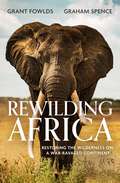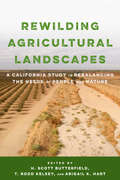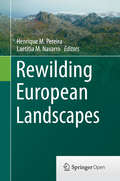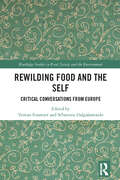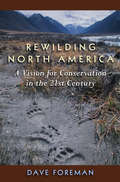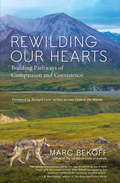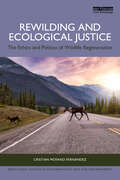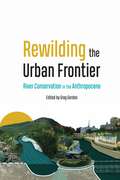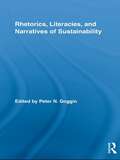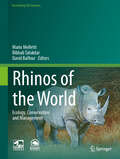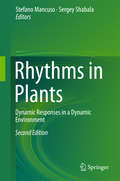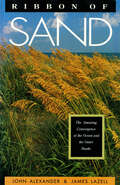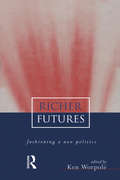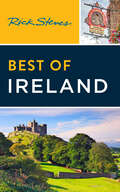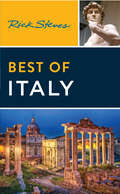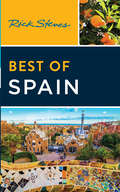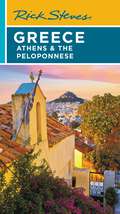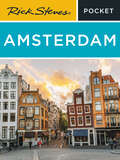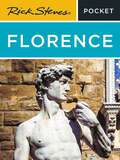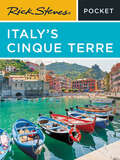- Table View
- List View
Rewilding Africa: Restoring the Wilderness on a War-ravaged Continent
by Graham Spence Grant FowldsConservationist Grant Fowlds lives to save and protect Africa's rhinos, elephants and other iconic wildlife, to preserve their habitats, to increase their range and bring back the animals where they have been decimated by decades of war, as in Angola, Mozambique and the Democratic Republic of the Congo. This vivid account of his work tells of a fellow conservationist tragically killed by the elephants he was seeking to save and a face-off with poachers, impoverished rural people exploited by rapacious local businessmen. Fowlds describes the impact of the Covid pandemic on conservation efforts, the vital wildlife tourism that sustains these and rural communities; and tells of conservationists' efforts to support people through the crisis. Lockdowns may have brought a welcome lull in rhino and other poaching, but also brought precious tourism to a standstill. He shows how the pandemic has highlighted the danger to the world of the illicit trade in endangered wildlife, some of it sold in 'wet markets', where pathogens incubate and spread. He describes a restoration project of apartheid-era, ex-South African soldiers seeking to make reparations in Angola, engulfed for many years in a profoundly damaging civil war, which drew in outside forces, from Cuba, Russia and South Africa, with a catastophic impact on that country's wildlife. Those who fund conservation, whether in the US, Zambia or South Africa itself, are of vital importance to efforts to conserve and rewild: some supposed angel-investors turn out to be not what they had appeared, some are thwarted in their efforts, but others are open-hearted and generous in the extreme, which makes their sudden, unexpected death an even greater tragedy. A passionate desire to conserve nature has also brought conservationists previously active in far-off Venezuela to southern Africa. Fowlds describes fraught meetings to negotiate the coexistence of wildlife and rural communities. There are vivid accounts of the skilled and dangerous work of using helicopters to keep wildebeest, carrying disease, and cattle apart, and to keep elephants from damaging communal land and eating crops such as sugar cane. He tells of a project to restore Africa's previously vast herds of elephants, particularly the famed 'tuskers', with their unusually large tusks, once prized and hunted almost to extinction. The range expansion that this entails is key to enabling Africa's iconic wildlife to survive, to preserving its wilderness and, in turn, helping humankind to survive.There is a heartening look at conservation efforts in Mozambique, a country scarred by years of war, which are starting to bear fruit, though just as a new ISIS insurgency creates havoc in the north of the country. What will humanity's relationship with nature be post-pandemic? Will we have begun to learn that by conserving iconic wildlife and their habitats we help to preserve and restore precious pockets of wilderness, which are so vital not only the survival of wildlife, but to our own survival on our one precious planet.
Rewilding Agricultural Landscapes: A California Study in Rebalancing the Needs of People and Nature
by H. Scott ButterfieldAs the world population grows, so does the demand for food, putting unprecedented pressure on agricultural lands. In many desert dryland regions, however, intensive cultivation is causing their productivity to decline precipitously. "Rewilding&” the least productive of these landscapes offers a sensible way to reverse the damage, recover natural diversity, and ensure long-term sustainability of remaining farms and the communities they support. This accessibly written, groundbreaking contributed volume is the first to examine in detail what it would take to retire eligible farmland and restore functioning natural ecosystems. The lessons in Rewilding Agricultural Landscapes will be useful to conservation leaders, policymakers, groundwater agencies, and water mangers looking for inspiration and practical advice for solving the complicated issues of agricultural sustainability and water management.
Rewilding European Landscapes
by Henrique M. Pereira Laetitia M. NavarroSome European lands have been progressively alleviated of human pressures, particularly traditional agriculture in remote areas. This book proposes that this land abandonment can be seen as an opportunity to restore natural ecosystems via rewilding. We define rewilding as the passive management of ecological successions having in mind the long-term goal of restoring natural ecosystem processes. The book aims at introducing the concept of rewilding to scientists, students and practitioners. The first part presents the theory of rewilding in the European context. The second part of the book directly addresses the link between rewilding, biodiversity, and habitats. The third and last part is dedicated to practical aspects of the implementation of rewilding as a land management option. We believe that this book will both set the basis for future research on rewilding and help practitioners think about how rewilding can take place in areas under their management.
Rewilding Food and the Self: Critical Conversations from Europe (Routledge Studies in Food, Society and the Environment)
by Tristan Fournier Sébastien DalgalarrondoThis volume contributes to the return to nature movement that is very much in vogue in contemporary European societies, by examining the place of food and eating in the "rewilding" process. It is divided into three parts, each of which consists of conversations between social scientists, with fieldwork collected from across Denmark, Finland, France, Italy, Norway and Switzerland. The first part focuses on the ways in which the hunter-gatherer livelihood has been transformed into a resilient, simpler and ecological way of life. It is dedicated to hunting and identifies the contexts in which large wild game meat is consumed and the reasons why such a product is still valued today. The second part shows how some practices that aim to reconnect with natural processes are developing within a market economy. Case studies on natural wine and fasting retreats help us to identify the promises that producers and promoters are relying on in order to disseminate them. Finally, the third part considers how this process of rewilding food is expressed in post-modernity. By focusing on two normative frameworks in which the rhetoric of the wild is mobilized although it is not expected to be in these terms – urbanity and the gender order – the goal is to understand the extent to which referring to the wild in food discourses and practices contributes to challenging our identities, and to creating possible forms of emancipation. This book will be of great interest to students and scholars interested in food cultures, human nature relationships, and sustainable diets.
Rewilding North America: A Vision For Conservation In The 21St Century
by Dave ForemanDave Foreman is one of North America's most creative and effective conservation leaders, an outspoken proponent of protecting and restoring the earth's wildness, and a visionary thinker. Over the past 30 years, he has helped set direction for some of our most influential conservation organizations, served as editor and publisher of key conservation journals, and shared with readers his unique style and outlook in widely acclaimed books including The Big Outside and Confessions of an Eco-Warrior.In Rewilding North America, Dave Foreman takes on arguably the biggest ecological threat of our time: the global extinction crisis. He not only explains the problem in clear and powerful terms, but also offers a bold, hopeful, scientifically credible, and practically achievable solution.Foreman begins by setting out the specific evidence that a mass extinction is happening and analyzes how humans are causing it. Adapting Aldo Leopold's idea of ecological wounds, he details human impacts on species survival in seven categories, including direct killing, habitat loss and fragmentation, exotic species, and climate change. Foreman describes recent discoveries in conservation biology that call for wildlands networks instead of isolated protected areas, and, reviewing the history of protected areas, shows how wildlands networks are a logical next step for the conservation movement. The final section describes specific approaches for designing such networks (based on the work of the Wildlands Project, an organization Foreman helped to found) and offers concrete and workable reforms for establishing them. The author closes with an inspiring and empowering call to action for scientists and activists alike.Rewilding North America offers both a vision and a strategy for reconnecting, restoring, and rewilding the North American continent, and is an essential guidebook for anyone concerned with the future of life on earth.
Rewilding Our Hearts: Building Pathways of Compassion and Coexistence
by Marc BekoffIn wildlife conservation, rewilding refers to restoring habitats and creating corridors between preserved lands to allow declining populations to rebound. Marc Bekoff, one of the world’s leading animal experts and activists, here applies rewilding to human attitudes. Rewilding Our Hearts invites readers to do the essential work of becoming reenchanted with the world, acting from the inside out, and dissolving false boundaries to truly connect with both nature and themselves.
Rewilding and Ecological Justice: The Ethics and Politics of Wildlife Regeneration (Routledge Studies in Conservation and the Environment)
by Cristian Moyano-FernándezThis book presents rewilding as a matter of ecological justice. To date, most books and articles on rewilding have viewed this concept through the lens of environmental science, while others have analyzed it from a political, ethical, and philosophical perspective. However, little attention has so far been paid to the justice angle of rewilding. Why and how should justice for rewilding be articulated? In order to address this question, Rewilding and Ecological Justice delves into the capabilities approach extended to nonhumans, distributive theories of ecological justice, welfare biology strategies applied to wildlife, environmental virtues, philosophies of recognition and identity, and decolonial studies. By discussing these narratives, this book is able to outline a roadmap indicating the key factors which should be considered in a justice approach to wildlife regeneration. Given the current and worsening socioecological crisis, rewilding initiatives are likely to increase, so this book explores how to ensure that their development is just for all, inclusive of both humans and nonhumans, drawing on examples from across the globe.This book will be of great interest to students and scholars of rewilding, ecological ethics and justice, environmental philosophy, biodiversity conservation, and ecological restoration.
Rewilding the Urban Frontier: River Conservation in the Anthropocene
by Char Miller Robert Bartlett Brian M. Murphy Christian C. Young Jennifer Stevens Shawn Bailey Heidi Lasher Margo Hill Marian L. Rice Kirsten Rudestam C. Ian Stevenson Bryan B. RasmussenMore so than other ecosystems, urban rivers typify our evolving relationship with nature. Once a necessity for the development of civilization, by the twentieth century America&’s rivers became neglected and abused, channelized, dammed, and filled with sewage and toxic waste. While acknowledging the profound impact our species has had on the natural world, and on rivers in particular, Rewilding the Urban Frontier argues that the Anthropocene presents opportunities for rethinking our relationship to the natural world and potentially healing the age-old rift between humans and nature. Although the Clean Water Act of 1972 spurred a cleanup of the nation&’s waterways, explosive urban growth has since fragmented the wildlife corridors and ecosystems along our rivers. The contributors to this volume contend that if done right, rewilding urban rivers can help avoid further loss of biodiversity and simultaneously address environmental and social inequities.
Rhetorics, Literacies, and Narratives of Sustainability (Routledge Studies in Rhetoric and Communication)
by Peter N. GogginIn this volume, rhetoricians, literacy scholars, and humanists have come together to examine the complex discursive constructions of sustainability. Touching on topics including conservation efforts in specific locales; social and political constructions of rhetorical place and space; community literacy; historical and archival analysis of institutional politics, policies, and practices concerning the environment and economic growth and development; town planning and zoning issues; and rhetorics of environmental remediation and sustainability, this collection of essays provides rhetoricians and environmentalists a window into the complex and often contradictory arena of discourse on sustainability.
Rhinoceros (Nature's Children)
by Merebeth SwitzerDid you know... That rhino horns never stop growing; That their calves are able to get up and run hours after birth; and that there are two types of rhino who have two horns. Learn more about these exciting creatures in this book.
Rhinos of the World: Ecology, Conservation and Management (Fascinating Life Sciences)
by Mario Melletti Bibhab Talukdar David BalfourThis book represents the culmination of more than four years of work by many rhino experts, primarily from Africa, Asia, the United States, and Europe, involved in rhino conservation, research and management. It is one of the most comprehensive reference works ever published on the systematics, ecology, conservation status, and management of all rhinoceros species. Covering all five rhino species worldwide, this volume brings together the contributions of 92 international rhino experts and provides: A comprehensive overview of the current state of knowledge on the evolution, phylogeny, systematics, and fossil record of rhinos An in-depth look at the ecology and conservation status of each species, with detailed chapters A series of case studies on conservation management, poaching, horn trade, and ex-situ programs. This beautifully illustrated book is an invaluable resource for researchers, wildlife managers and professionals in conservation biology, ecology, and management, as well as the general public. It reveals the fascinating story of rhino evolution, the long history of human interactions with rhinos, and the major threats to these iconic species.
Rhythms in Plants
by Sergey Shabala Stefano MancusoThis second edition of a well-received book focuses on rhythmic behaviour in plants, which regulates all developmental and adaptive responses and can thus be regarded as quintessential to life itself. The chapters provide a timely update on recent advances in this field and comprehensively summarize the current state of knowledge concerning the molecular and physiological mechanisms behind circadian and ultradian oscillations in plants, their physiological implications for growth and development and adaptive responses to a dynamic environment. Written by a diverse group of leading researchers, the book will spark the interest of readers from many branches of science: from physicists and chemists wishing to learn about the multi-faceted rhythms in plants, to biologists and ecologists involved in the state-of-the-art modelling of complex rhythmic phenomena.
Ribbon of Sand: The Amazing Convergence of the Ocean and the Outer Banks (Chapel Hill Bks.)
by John Alexander James LazellWind, currents, tides, and sand. Kingsnakes and rice rats. The disappearance of the Lost Colony, the raids of the pirate Blackbeard, and the Wright brothers' first attempts at flight. The Outer Banks is a place like no other.
Richer Futures: Fashioning a new politics (Earthscan Library Collection: Environmental And Resource Economics Set Ser.)
by Ken WorpoleIn every area of life, traditional, centralized party politics has been failing and the seeds of a new form of political life are being sown. This is true in housing, health, education, consumption and transport, where public policy is attracting increasing criticism. In an age of social alienation and urban despondency Richer Futures is a timely response to the growing interest in community-based, self-help action. It introduces new forms of communication and decision-making and sets out a programme for a sustainable politics.Contributions from some of the best-known thinkers and writers on contemporary urban, cultural and social policy (and campaigns) in Britain today pay tribute to the ideas and industrious activities of the influential writer and commentator Colin Ward. This uplifting collection of essays looks forward to a new politics of self-management and environmentally aware and sustainable lifestyles.Ken Worpole has written a number of books on urban and cultural policy, and a series of influential reports for Comedia, Demos and the Department of the Environment.Originally published in 1999
Rick Steves Best of Ireland (Rick Steves Ser.)
by Rick Steves Pat O'ConnorHit Ireland's can't-miss sights, bites, and history in two weeks or less with Rick Steves Best of Ireland!Strategic advice from Rick Steves on what's worth your time and money Two-day itineraries covering Dublin, Kilkenny, Kinsale, Kenmare and the Ring of Kerry, Dingle Town and Peninsula, County Clare, Galway, Aran Islands, Belfast, Portrush, and the Antrim Coast Rick's tips for beating the crowds, skipping lines, and avoiding tourist traps The best of local culture, flavors, and more, including insightful walks through the most interesting neighborhoods and museums Trip planning strategies like how to link destinations and design your itinerary, what to pack, where to stay, and how to get around Over 350 full-color pages with detailed maps and vibrant photos throughout Suggestions for side trips to Valley of the Boyne, Wicklow Mountains, Rock of Cashel, Cobh, Blarney Castle, Connemara and Mayo, Bangor, and Derry Experience Ireland's legendary warmth and beauty for yourself with Rick Steves Best of Ireland! Planning a longer trip? Pick up Rick Steves Ireland, an in-depth guide perfect for spending more than two weeks exploring Ireland.
Rick Steves Best of Italy
by Rick StevesHit Italy's can't-miss art, sights, and bites in two weeks or less with Rick Steves Best of Italy!Strategic advice from Rick Steves on what's worth your time and money Two-day itineraries covering Venice, the Cinque Terre, Florence, the Hill Towns of Central Italy, Rome, Naples, Sorrento, and the Amalfi Coast Rick's tips for beating the crowds, skipping lines, and avoiding tourist traps The best local culture, flavors, and more, including insightful walks through museums, historic sights, and atmospheric neighborhoods Trip planning strategies like how to link destinations and design your itinerary, what to pack, where to stay, and how to get around Over 500 full-color pages with detailed maps and vibrant photos throughout Suggestions for day trips to Milan, Lake Como, Pisa, Verona, and Padua Experience Italy's Old World romance and New World excitement for yourself with Rick Steves Best of Italy! Planning a longer trip? Pick up Rick Steves Italy, an in-depth guide perfect for spending more than two weeks exploring Italy.
Rick Steves Best of Spain (Rick Steves Travel Guide)
by Rick StevesHit Spain's can't-miss art, sights, and bites in two weeks or less with Rick Steves Best of Spain!Strategic advice from Rick Steves on what's worth your time and money Short itineraries covering Barcelona, Madrid, Toledo, Granada, Andalucía's White Hill Towns, and Sevilla Rick's tips for beating the crowds, skipping lines, and avoiding tourist traps The best of local culture, flavors, and more, including insightful walks through museums, historic sights, and atmospheric neighborhoods Trip planning strategies like how to link destinations and design your itinerary, what to pack, where to stay, and how to get around Over 400 full-color pages with detailed maps and vibrant photos throughout Suggestions for side trips to Montserrat and Figueres, Basque Country, Santiago de Compostela, El Escorial, Segovia, Salamanca, Córdoba, and Spain's South Coast Experience Spain's old world romance and new world excitement for yourself with Rick Steves Best of Spain! Planning a longer trip? Pick up Rick Steves Spain, an in-depth guide perfect for spending more than two weeks exploring Spain.
Rick Steves Greece: Athens & the Peloponnese
by Rick StevesWalk in the steps of Socrates, test the acoustics of the amphitheater of Epidavros, and set sail for Santorini: with Rick Steves, Greece is yours to explore! Inside Rick Steves Greece: Athens & The Peloponnese you'll find:Comprehensive coverage for spending two weeks or more exploring Greece Rick's strategic advice on how to get the most out of your time and money, with rankings of his must-see favorites Top sights and hidden gems, from the Parthenon and the Agora to the small towns and beaches of the Peloponnesian Peninsula How to connect with culture: Go back in time at the National Archaeological Museum, sample olives and feta in the Mediterranean sunshine, or sip ouzo at a local taverna Beat the crowds, skip the lines, and avoid tourist traps with Rick's candid, humorous insight The best places to eat, sleep, and relaxSelf-guided walking tours of lively neighborhoods and incredible museums Detailed maps for exploringon the goUseful resources including a packing list, a Greek phrase book, a historical overview, and recommended reading Over 500 bible-thin pages include everything worth seeing without weighing you down Complete, up-to-date information on Athens, Nafplio, Epidavros, Mycenae, Olympia, Patra, Kardamyli, the Mani Peninsula, Sparta, Mystras, Delphi, Hydra, Mykonos, Delos, Santorini, and more Make the most of every day and every dollar with Rick Steves Greece: Athens & the Peloponnese. Spending a week or less in the city? Check out Rick Steves Pocket Athens!
Rick Steves Paris (Rick Steves Ser.)
by Rick Steves Gene Openshaw Steve SmithNow more than ever, you can count on Rick Steves to tell you what you really need to know when traveling through Paris. From the top of the Eiffel Tower to the ancient catacombs below the city, explore Paris at every level with Rick Steves! Inside Rick Steves Paris you'll find:Comprehensive coverage for spending a week or more exploring Paris Rick's strategic advice on how to get the most out of your time and money, with rankings of his must-see favorites Top sights and hidden gems, from the Louvre and the Palace of Versailles to where to find the perfect croissant How to connect with culture: Stroll down Rue Cler for fresh, local goods to build the ultimate French picnic, marvel at the works of Degas and Monet, and sip café au lait at a streetside café Beat the crowds, skip the lines, and avoid tourist traps with Rick's candid, humorous insight The best places to eat, sleep, and relax with a glass of vin rougeSelf-guided walking tours of lively neighborhoods and incredible museums and churches Detailed maps for exploring on the go Over 700 bible-thin pages include everything worth seeing without weighing you down Complete, up-to-date information on the best arrondissements in Paris,including Champs-Elysees, the Marais, Montmartre, and more, plus day trips to Versailles, Chartres, Giverny, and Auvers-sur-Oise Make the most of every day and every dollar with Rick Steves Paris. Spending just a few days in the city? Try Rick Steves Pocket Paris.
Rick Steves Pocket Amsterdam (Rick Steves Pocket)
by Rick Steves Gene OpenshawMake the most of every day and every dollar with Rick Steves! This colorful, compact guidebook is perfect for spending a week or less in Amsterdam: City walks and tours: Six detailed tours and walks showcase Amsterdam's essential sights, including the Rijksmuseum, Van Gogh Museum, and the Anne Frank House, plus neighborhood walks through the Red Light District, Jordaan, and the historic city centerRick's strategic advice on what experiences are worth your time and money What to eat and where to stay: Sample pickled herring and friets with mayonnaise, chat with locals over a pint of pils, and cozy up in a canalside hotel Day-by-day itineraries to help you prioritize your timeA detailed, detachable fold-out map, plus museum and city maps throughoutFull-color, portable, and slim for exploring on-the-goTrip-planning practicalities like when to go, how to get around, basic Dutch phrases, and moreLightweight yet packed with valuable insight into Amsterdam's history and culture, Rick Steves Pocket Amsterdam truly is a tour guide in your pocket. Expanding your trip? Try Rick Steves Amsterdam & the Netherlands!
Rick Steves Pocket Florence
by Rick StevesMake the most of every day and every dollar with Rick Steves! This colorful, compact guidebook is perfect for spending a week or less in Florence:City walks and tours: Five detailed tours and walks showcase Florence's essential sights, including the Uffizi Gallery, the Duomo, and Michelangelo's David at the Accademia, plus specific recommendations for each neighborhood Rick's strategic advice on what's worth your time and money What to eat and where to stay: Sample artisanal gelato, chat with locals over a glass of Chianti, and enjoy the Old-World ambience of a Florentine bed and breakfast Day-by-day itineraries to help you prioritize your time A detailed, detachable fold-out map, plus museum and city maps throughout Full-color, portable, and slim for exploring on the goTrip-planning practicalities like when to go, how to get around, basic Italian phrases, and more Lightweight yet packed with information on what to do and see, Rick Steves Pocket Florence truly is a tour guide in your pocket. Spending more time in the region? Try Rick Steves Florence & Tuscany.
Rick Steves Pocket Italy's Cinque Terre
by Rick Steves Gene OpenshawMake the most of every day and every dollar with Rick Steves! This colorful, compact guidebook is perfect for spending a week or less in Italy's Cinque Terre: City walks and tours: Six detailed tours and walks showcase the essential sights of each village, including Monterosso al Mare, Vernazza, Riomaggiore, and more Rick's strategic advice on which experiences are worth your time and money What to eat and where to stay: Enjoy local wine and seafood antipasti, chat with locals at a family-run trattoria, and admire views of the ocean from your hotel Day-by-day itineraries to help you prioritize your time A detailed, detachable fold-out map, plus individual village maps throughout Full-color, portable, and slim for exploring on the go Trip-planning practicalities like when to go, how to get around, and more Lightweight yet packed with valuable insight into the history and culture of Italy, Rick Steves Pocket Italy's Cinque Terre truly is a tour guide in your pocket. Expanding your trip? Try Rick Steves Italy!
Rick Steves Pocket Munich & Salzburg (Rick Steves Pocket)
by Rick StevesMake the most of every day and every dollar with Rick Steves! This colorful, compact guidebook is perfect for spending a week or less in Munich and Salzburg: City walks and tours: Five detailed self-guided walks including a Munich city walk, Nymphenburg Palace tour, Sound of Music tour, and more Rick's strategic advice on what's worth your time and money What to eat and where to stay: Savor Bratwurst from a streetside Würstelstand, mingle with locals at a beer hall, and stay at a traditional Bavarian bed-and-breakfast Day-by-day itineraries to help you prioritize your time A detailed, detachable fold-out map, plus museum and city maps throughout Full-color, portable, and slim for exploring on-the-goTrip-planning practicalities like when to go, how to get around, basic German phrases, and more Lightweight, yet packed with info on the cities' history and culture, Rick Steves Pocket Munich & Salzburg truly is a tour guide in your pocket. Extending your trip? Try Rick Steves Best of Germany.
Rick Steves Pocket Prague (Rick Steves)
by Rick Steves Honza VihanMake the most of every day and every dollar with Rick Steves! This colorful, compact guidebook is perfect for spending a week or less in Prague:City walks and tours: Five detailed self-guided walks, including a walk from the Old Town Square to the Charles Bridge and tours of the Jewish Quarter and Prague Castle Rick's strategic advice on what's worth your time and money What to eat and where to stay: Savor a traditional goulash stew, mingle with locals over a Czech beer or two, and stay in a romantic hotel Day-by-day itineraries to help you prioritize your time A detailed, detachable fold-out map, plus museum and city maps throughout Full-color, portable, and slim for exploring on-the-go Trip-planning practicalities like when to go, how to get around, basic Czech phrases, and more Lightweight, yet packed with info on Prague's history and culture, Rick Steves Pocket Prague truly is a tour guide in your pocket. Extending your trip? Try Rick Steves Prague & the Czech Republic. About Moon Travel Guides: Moon was founded in 1973 to empower independent, active, and conscious travel. We prioritize local businesses, outdoor recreation, and traveling strategically and sustainably. Moon Travel Guides are written by local, expert authors with great stories to tell—and they can't wait to share their favorite places with you. For more inspiration, follow @moonguides on social media.
Rick Steves Pocket Venice (Rick Steves Ser.)
by Rick Steves Gene OpenshawMake the most of every day and every dollar with Rick Steves! This colorful, compact guidebook is perfect for spending a week or less in Venice:City walks and tours: Eight detailed tours and walks showcase Venice's essential sights, including St. Mark's Basilica, the Doge's Palace, and the Grand Canal, plus handy neighborhood breakdowns Rick's strategic advice on what experiences are worth your time and money What to eat and where to stay: Savor calamari at a cicchetti bar, mingle with locals with a spritz con Aperol in hand, and stay in a romantic canal-side hotel Day-by-day itineraries to help you prioritize your time A detailed, detachable fold-out map, plus museum and city maps throughout Full-color, portable, and slim for exploring on the goTrip-planning practicalities like when to go, how to get around, and more Lightweight yet packed with valuable insight into Venice's history and culture, Rick Steves Pocket Venice truly is a tour guide in your pocket. Spending more than a week in the city? Try Rick Steves Venice.
